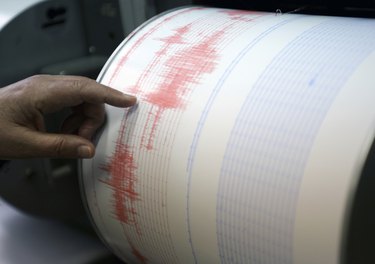
Chang Heng of China invented the oldest known tool used in seismology in 132 CE. Seismology, from the Greek word for earthquake, "seismos" is the study of earthquakes. Scientists use a number of tools, both historic and modern to study earthquake events both past and present in hopes of better predicting future events and developing more in-depth knowledge about how and when earthquakes occur.
Seismometers and Seismographs
Video of the Day
In older models of seismographs, a stylus created a seismogram -- a visual drawing recorded on paper which illustrated the size and duration of the seismic waves created by an earthquake. Contemporary seismographs now record digital information about the magnitude of an earthquake. A network of seismographs placed around the globe constantly measures each shift in the Earth's crust, recording intensity and duration of the quake and aftershocks. The U.S. Geological Survey defines seismometers as sensitive detectors that when connected to a system that produces a permanent recording are called a seismograph.
Video of the Day
GPS Networks
Global positioning satellite systems, or GPS, are used to measure slight movements of the Earth's crust. The satellite transmits a signal to a fixed ground station, and after a shift, the distance the station has moved is examined. According to the National Aeronautics and Space Administration, the integrated GPS system allows measurements in millimeters and scientists are analyzing the data to see if these measurements may be used to predict future earthquake events.
Theodolites
The San Francisco State University Fault Creep Monitoring Project uses theodolites, instruments that surveyors use to measure angles, to measure "creep" or the deformation of the Earth's crust as a reaction to stress. Creep movement occurs in the time between "stress releasing" earthquakes and measurement of this movement provides scientists with additional data for earthquake forecasting. Three points are predetermined and marked using survey monuments. Theodolites are then used to figure changes over time by comparing measurements of the angles of the markers at regular intervals.
Creep-meter
Creep-meters also measure fault line shifts in the Earth's crust between earthquake events. A creep-meter consists of a rod placed into a fault, after which the movement of a "free" end is monitored. Creep-meters monitor only tiny areas, measured in millimeters.
Strain-meter
A more modern instrument utilized in seismology is the strain-meter. A strain-meter is a small cylinder, inserted more than 500 feet deep beneath the Earth's surface, which measures movements or "strain" in the materials surrounding the device. It monitors a volume of liquid, usually oil, within the cylinder as the surrounding rocks and materials push the liquid into an adjoining chamber.